THE HOUSTON HURRICANE POLLUTION-SNIFFING NASA FLIGHT THAT NEVER TOOK OFF 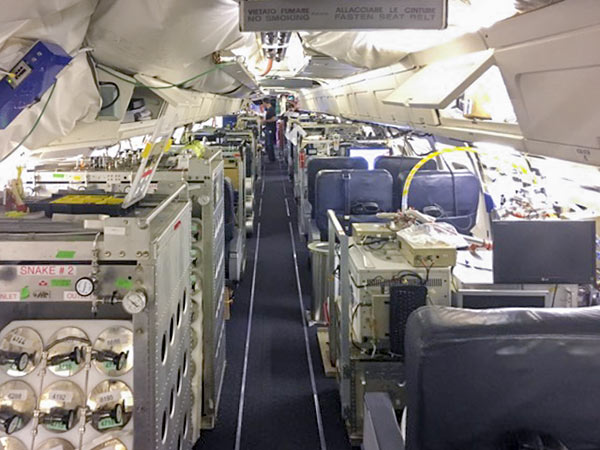 A week and a half after Hurricane Harvey hit Houston, as damage to smokestacks, pipelines, and chemical storage tanks were still being assessed, flooded Superfund sites went unmonitored, and clouds of benzene and other chemicals assembled in the skies over the city, the crew of a California-based airborne NASA chemical lab offered to help figure out the state of affairs — by diverting its specially equipped DC-8 from a planned trip to Oklahoma to take measurements in Houston instead. But EPA and TCEQ officials vehemently passed on the offer. An email response from TCEQ air toxicologist Michael Honeycutt noted that “state data showed no sign for concern,” report the L.A. Times‘s Susanne Rust and Louis Sahagun. “We don’t think your data would be useful for source identification while industry continues to restart their operations,” wrote Honeycutt, who the following month was appointed to head the EPA’s Science Advisory Board by President Trump. David Gray, the EPA official in charge of the Harvey emergency response, agreed. Citing emails from Texas officials “stating unambiguously that they do not want NASA to use the DC-8 for any data acquisition,” Michael Freilich, the director of NASA’s Earth Sciences division, called off the mission. [L.A. Times] Photo of Atmospheric Tomography Mission DC-8 interior, September 2017: NASA
A week and a half after Hurricane Harvey hit Houston, as damage to smokestacks, pipelines, and chemical storage tanks were still being assessed, flooded Superfund sites went unmonitored, and clouds of benzene and other chemicals assembled in the skies over the city, the crew of a California-based airborne NASA chemical lab offered to help figure out the state of affairs — by diverting its specially equipped DC-8 from a planned trip to Oklahoma to take measurements in Houston instead. But EPA and TCEQ officials vehemently passed on the offer. An email response from TCEQ air toxicologist Michael Honeycutt noted that “state data showed no sign for concern,” report the L.A. Times‘s Susanne Rust and Louis Sahagun. “We don’t think your data would be useful for source identification while industry continues to restart their operations,” wrote Honeycutt, who the following month was appointed to head the EPA’s Science Advisory Board by President Trump. David Gray, the EPA official in charge of the Harvey emergency response, agreed. Citing emails from Texas officials “stating unambiguously that they do not want NASA to use the DC-8 for any data acquisition,” Michael Freilich, the director of NASA’s Earth Sciences division, called off the mission. [L.A. Times] Photo of Atmospheric Tomography Mission DC-8 interior, September 2017: NASA
Tag: Disaster Aftermath
OTHER LOCAL RECIPIENTS OF THE UAE’S HARVEY FOREIGN AID CHECK: LIBRARY, HOMELESS SHELTER, KIDS HEALTH SQUAD 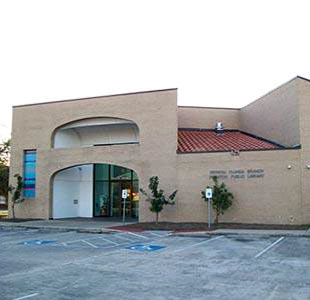 Also receiving a chunk of that $6.5 million check that the United Arab Emerites announced its cutting Houston: the city’s Flores Neighborhood Library branch at 110 N. Milby St. It’s been closed since Harvey, but the books and equipment inside the building at Milby and Canal are mostly in decent shape, a spokesperson for Councilwoman Karla Cisneros told the Chronicle‘s Alyson Ward last summer. (The floor and drywall, she says, are another story.) $800,000 will go toward repairs as well as “upgrades to the library’s programming and computer lab and the purchase of new furniture,” according to the city’s press release. Beyond the library, a new homeless shelter to be built in an unspecified location will also get in on the UAE aid money: $2 million of it. Dubbed The Navigation Center, it’ll provide temporary housing for folks waiting on somewhere else more permanent and will also function as a disaster recovery shelter during storms. And last but not least, Houston’s health department is getting $1.1 million, which it’ll use to fight environmentally-induced illnesses in children. How so? By bringing its asthma education program into 3 more ISD schools, testing kdis for blood lead poisoning, and creating a new illness screening team its calling the Children’s Environmental Health Mobile Unit. [City of Houston] Photo: Houston Public Library
Also receiving a chunk of that $6.5 million check that the United Arab Emerites announced its cutting Houston: the city’s Flores Neighborhood Library branch at 110 N. Milby St. It’s been closed since Harvey, but the books and equipment inside the building at Milby and Canal are mostly in decent shape, a spokesperson for Councilwoman Karla Cisneros told the Chronicle‘s Alyson Ward last summer. (The floor and drywall, she says, are another story.) $800,000 will go toward repairs as well as “upgrades to the library’s programming and computer lab and the purchase of new furniture,” according to the city’s press release. Beyond the library, a new homeless shelter to be built in an unspecified location will also get in on the UAE aid money: $2 million of it. Dubbed The Navigation Center, it’ll provide temporary housing for folks waiting on somewhere else more permanent and will also function as a disaster recovery shelter during storms. And last but not least, Houston’s health department is getting $1.1 million, which it’ll use to fight environmentally-induced illnesses in children. How so? By bringing its asthma education program into 3 more ISD schools, testing kdis for blood lead poisoning, and creating a new illness screening team its calling the Children’s Environmental Health Mobile Unit. [City of Houston] Photo: Houston Public Library
COMMENT OF THE DAY: WHY IT PAYS TO RAISE THOSE FLOODED MEYERLAND HOMES 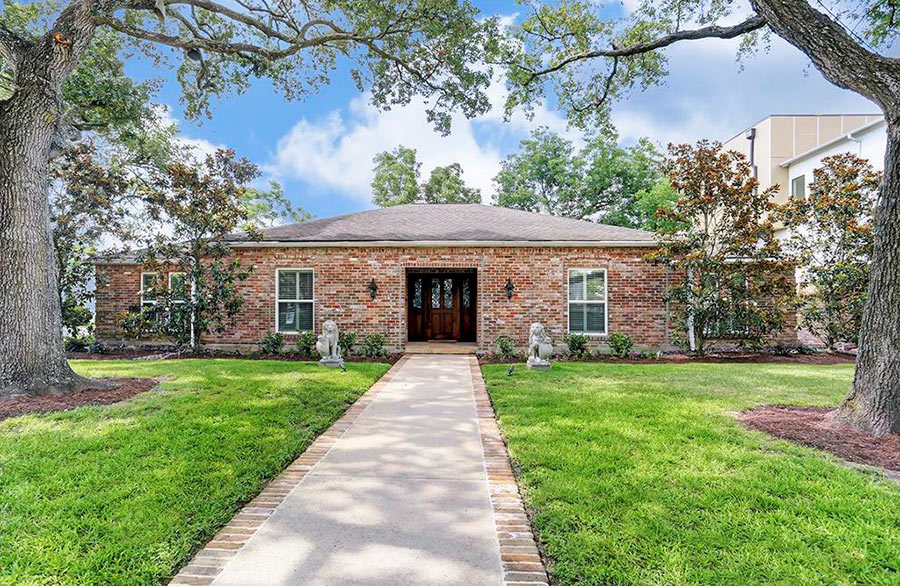 “Also, let’s remember that flood insurance pays out $250k for structure and $100k for contents max (and these Meyerland homes are pricey, so maxing out the payment is possible). So, paying $350k to raise a house to avoid a future claim is — long-term — a better use of money. Yes, the amount itself is a shock out of context. Yes, it borders on ridiculous that this is related to the 2015 flood. Yes, the tax base would benefit more from paying to knock down the house and build new million dollar homes, but this is a better solution than buying the properties and removing them from the tax base.” [travelguy, commenting on What Houston Will Spend To Raise a Few Floody Houses in Meyerland] Photo of 5150 Braesheather Dr., to be elevated: HAR
“Also, let’s remember that flood insurance pays out $250k for structure and $100k for contents max (and these Meyerland homes are pricey, so maxing out the payment is possible). So, paying $350k to raise a house to avoid a future claim is — long-term — a better use of money. Yes, the amount itself is a shock out of context. Yes, it borders on ridiculous that this is related to the 2015 flood. Yes, the tax base would benefit more from paying to knock down the house and build new million dollar homes, but this is a better solution than buying the properties and removing them from the tax base.” [travelguy, commenting on What Houston Will Spend To Raise a Few Floody Houses in Meyerland] Photo of 5150 Braesheather Dr., to be elevated: HAR
WHAT HOUSTON WILL SPEND TO RAISE A FEW FLOODY HOUSES IN MEYERLAND  Houston City Council approved construction yesterday to raise 5 Meyerland houses — a subset of the 42 Houston homes FEMA paid the city $14.8 million to elevate back in 2015. One of those 42 houses has already been jacked up and 8 more are currently within the levitation process, according to the Chronicle’s Rebecca Elliott and John D. Harden. The costs to raise the 5 homes now slated for elevation 12 ft. above flood level — which include a few extra thousand dollars to put residents up in temporary lodging — range from $218,700 to $416,000 per property. In total, the bill comes to $1.6 million. Harris County appraises the total value of properties themselves from $125,906 to $507,152, with the value of improvements within that ranging from $34,700 to $201,200. One of the houses — 5150 Braesheather Dr. — shown above as it appeared before Harvey, is currently listed for sale. [Houston Chronicle; more info (items 24–28)] Photo of 5150 Braesheather Dr.: HAR
Houston City Council approved construction yesterday to raise 5 Meyerland houses — a subset of the 42 Houston homes FEMA paid the city $14.8 million to elevate back in 2015. One of those 42 houses has already been jacked up and 8 more are currently within the levitation process, according to the Chronicle’s Rebecca Elliott and John D. Harden. The costs to raise the 5 homes now slated for elevation 12 ft. above flood level — which include a few extra thousand dollars to put residents up in temporary lodging — range from $218,700 to $416,000 per property. In total, the bill comes to $1.6 million. Harris County appraises the total value of properties themselves from $125,906 to $507,152, with the value of improvements within that ranging from $34,700 to $201,200. One of the houses — 5150 Braesheather Dr. — shown above as it appeared before Harvey, is currently listed for sale. [Houston Chronicle; more info (items 24–28)] Photo of 5150 Braesheather Dr.: HAR
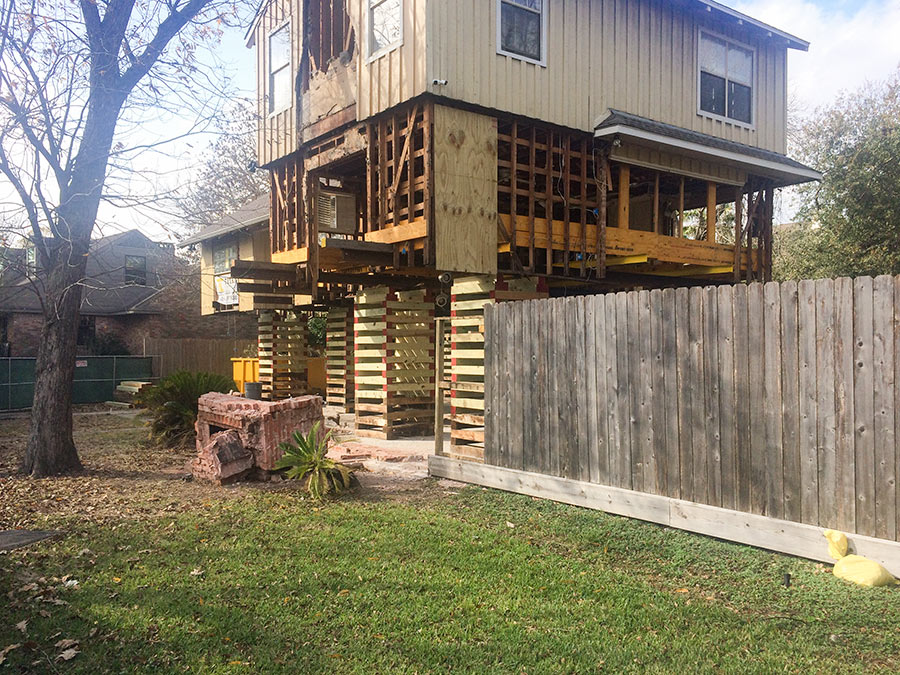
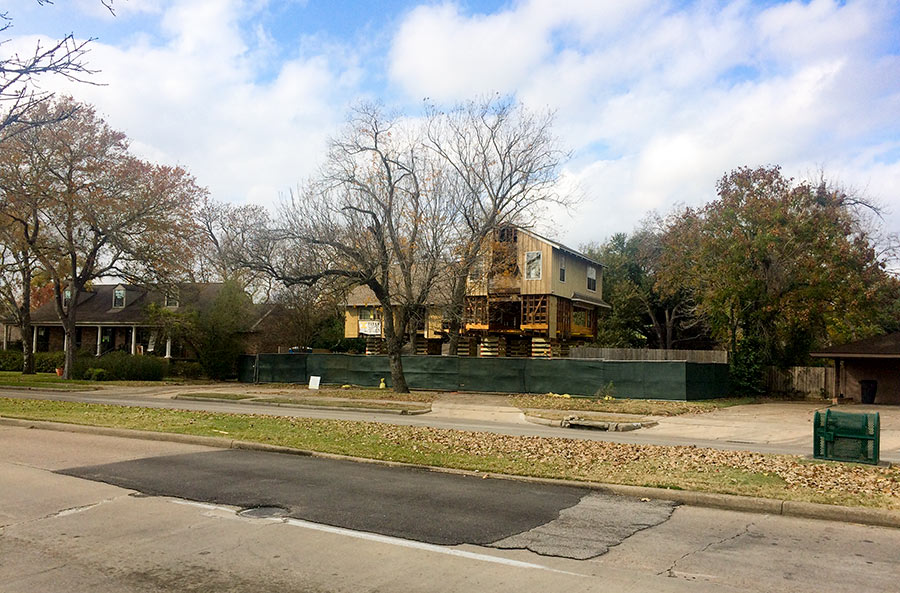
Everyone likes a good comeback story: 2 N. Braeswood houses a few doors down from the West Loop are rising above their floody circumstances with the help of wood-framed columns placed below their foundations. The photos above show 4718 N. Braeswood, just outside the West Loop, lifted on stilts months after Hurricane Harvey showered it with attention. The house’s chimney has been removed, leaving a gap in its street-facing facade.
Two doors down, 4710 N. Braeswood now sits at a similar elevation:
WHAT IT TAKES TO JACK A HOUSE 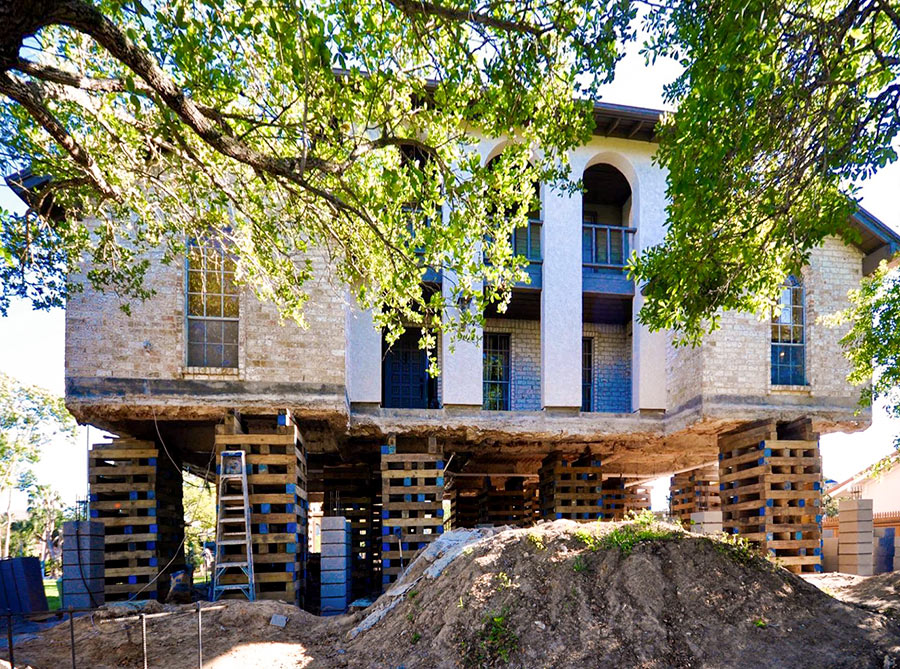 “Adam Bakir, a Houston builder and remodeler, does one or two home elevations a year. The job is akin to major surgery. Workers tunnel under the house, Bakir said, then raise the whole thing on jacks—the slab and the house that rests on it. Since Harvey, Bakir has received more than 20 inquiries about home elevation. If potential customers ask for a cost estimate, he’ll tell them: between about $75 and $100 per square foot. ‘If you have a 2,500-square-foot house, which is typical,’ he said, ‘the upper end of it would be about $250,000. The lower end, around $180,000.‘” [CityLab] Photo: Arkitektura Development
“Adam Bakir, a Houston builder and remodeler, does one or two home elevations a year. The job is akin to major surgery. Workers tunnel under the house, Bakir said, then raise the whole thing on jacks—the slab and the house that rests on it. Since Harvey, Bakir has received more than 20 inquiries about home elevation. If potential customers ask for a cost estimate, he’ll tell them: between about $75 and $100 per square foot. ‘If you have a 2,500-square-foot house, which is typical,’ he said, ‘the upper end of it would be about $250,000. The lower end, around $180,000.‘” [CityLab] Photo: Arkitektura Development
COMMENT OF THE DAY: THE ONLY MACKIE AND KAMRATH HOMES LEFT ON THE TIEL WAY LOOP 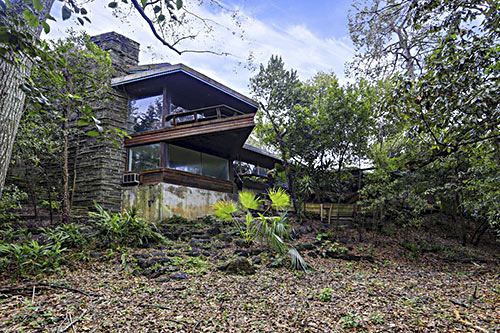 “. . . My husband and I drove around Tiel Way after the storm to check on all the MacKie and Kamraths. There were several homes on the street that flooded — and not just by a few inches but into their second levels. One of the things that make the Kamraths of this era (and really, many high-end midcentury homes) so gorgeous and unique is the abundant use of wood panels for all walls, doors, built-in storage cabinets and seating — everything. But it also makes them particularly expensive and hard to fix after extensive water damage.
As Swamplot reported earlier this year, the home at 2 Tiel Way was bought with the intention to restore but had so much termite and water damage it would have cost double to restore compared to a full rebuild price. So that’s what they are doing: rebuilding the same house. . . . It’s a controversial choice but in my opinion it’s the best architectural conservation alternative to demolition. But not everyone has the resources to undertake something like a full architectural rebuild. So while the demo of this house, one of Kamrath’s finest, is certainly a punch in the gut . . . I get it. They probably would have saved it if they could.
Tiel Way was the last concentration of MacKie and Kamrath’s great residential works, at one point having 7 homes on the loop. After this demolition we will be down to 2.5: the Gold Brick–awarded restoration at 67 Tiel Way (which thankfully, did not appear to have Harvey flooding issues), Kamrath’s own residence at 8 Tiel Way (definitely flooded, but appears to be safe at the moment), and the rebuild currently in progress at 2 Tiel Way.
48 Tiel Way won’t be the only midcentury treasure lost to Harvey, but it’s certainly one of the saddest to see go.” [Rabbit, commenting on Daily Demolition Report: Tiel Repeal; previously on Swamplot] Photo of 48 Tiel Way: HAR
“. . . My husband and I drove around Tiel Way after the storm to check on all the MacKie and Kamraths. There were several homes on the street that flooded — and not just by a few inches but into their second levels. One of the things that make the Kamraths of this era (and really, many high-end midcentury homes) so gorgeous and unique is the abundant use of wood panels for all walls, doors, built-in storage cabinets and seating — everything. But it also makes them particularly expensive and hard to fix after extensive water damage.
As Swamplot reported earlier this year, the home at 2 Tiel Way was bought with the intention to restore but had so much termite and water damage it would have cost double to restore compared to a full rebuild price. So that’s what they are doing: rebuilding the same house. . . . It’s a controversial choice but in my opinion it’s the best architectural conservation alternative to demolition. But not everyone has the resources to undertake something like a full architectural rebuild. So while the demo of this house, one of Kamrath’s finest, is certainly a punch in the gut . . . I get it. They probably would have saved it if they could.
Tiel Way was the last concentration of MacKie and Kamrath’s great residential works, at one point having 7 homes on the loop. After this demolition we will be down to 2.5: the Gold Brick–awarded restoration at 67 Tiel Way (which thankfully, did not appear to have Harvey flooding issues), Kamrath’s own residence at 8 Tiel Way (definitely flooded, but appears to be safe at the moment), and the rebuild currently in progress at 2 Tiel Way.
48 Tiel Way won’t be the only midcentury treasure lost to Harvey, but it’s certainly one of the saddest to see go.” [Rabbit, commenting on Daily Demolition Report: Tiel Repeal; previously on Swamplot] Photo of 48 Tiel Way: HAR
COMMENT OF THE DAY: WHAT FLOODING ON THE WEST SIDE TOOK AWAY  “Homes underwater for extended periods can be rebuilt, as long as they were not subjected to currents sufficient to cause major structural damage or foundation scour. They just take longer to dry out (ours took over a month).
Like Local Planner said, in many of the flooded neighborhoods north of the bayou, original-condition homes had basically no value before the flood (i.e. they were being sold for lot value and torn down). The process is indeed accelerating, with new builds being elevated à la Bellaire and Meyerland.
The big question mark for me is how much of a market there’ll be for $1+ million new homes in a potentially flood-prone area (even if your elevated home doesn’t flood during the next big one, you’d likely lose the cars in your non-elevated garage and need to be evac’d by boat). The market was soft in the Energy Corridor even before the flood. A new supply of high-end homes doesn’t automatically beget demand. Hopefully the new MD Anderson complex in the area will help (and potentially spur further diversification of employment in the Energy Corridor beyond oil and gas).” [Grant, commenting on Daily Demolition Report: Memorial Glint] Illustration: Lulu
“Homes underwater for extended periods can be rebuilt, as long as they were not subjected to currents sufficient to cause major structural damage or foundation scour. They just take longer to dry out (ours took over a month).
Like Local Planner said, in many of the flooded neighborhoods north of the bayou, original-condition homes had basically no value before the flood (i.e. they were being sold for lot value and torn down). The process is indeed accelerating, with new builds being elevated à la Bellaire and Meyerland.
The big question mark for me is how much of a market there’ll be for $1+ million new homes in a potentially flood-prone area (even if your elevated home doesn’t flood during the next big one, you’d likely lose the cars in your non-elevated garage and need to be evac’d by boat). The market was soft in the Energy Corridor even before the flood. A new supply of high-end homes doesn’t automatically beget demand. Hopefully the new MD Anderson complex in the area will help (and potentially spur further diversification of employment in the Energy Corridor beyond oil and gas).” [Grant, commenting on Daily Demolition Report: Memorial Glint] Illustration: Lulu
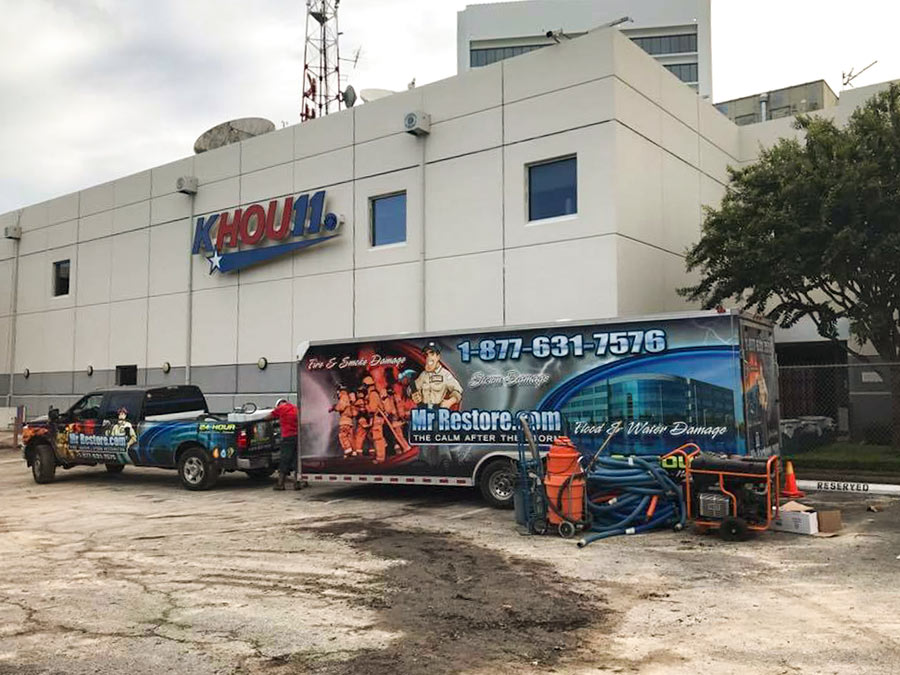
Teevee station KHOU is giving up on its 3.2-acre bayou-side home on Allen Pkwy. after repeated flooding and will soon be listing it for sale, according to a staff member’s Facebook post. The organization did file a permit for $594,740 worth of restoration work after Harvey between August and October, and hired 2 services to help with the clean-up — including Lewisville-based MrRestore, pictured above outside the building on August 30. Before Harvey, the studio enjoyed a 16-year dry run bookended by waters from Tropical Storm Allison back in 2001.
The 52,000-sq.-ft. studio, home to Channel 11 for 57 years, took on 5 ft. of water during the recent storm, forcing its staff to relocate broadcasting activity 3 times within the same day: first to a second floor conference room, then 2 blocks east on Allen Pkwy. to the Federal Reserve Bank, and finally to Houston Public Media’s office on Elgin St. just off I-45, where the news operation has now been headquartered for just over 2 months. That co-location wouldn’t be permanent, KHOU meteorologist Brooks Garner reported last month, although he indicated at that time that the station had not as yet decided whether to return home or seek a new venue.
Photos tweeted out by KHOU reporters of their original home showed the building at 1945 Allen Pkwy. taking on water during the storm. Here’s what the lobby looked like:
The U.S. Chemical Safety Board’s animated video (above) on the explosions at the Arkema Chemical Plant in Crosby recounts the steps taken by the brave workers stuck in charge of the facility in the aftermath of Hurricane Harvey. But a few angles less charitable to the company’s emergency planning effort aren’t included — possibly because they’d be a little more involved to animate. For example, the noxious fumes that emanated from the first fire, on the night of August 31, which according to a lawsuit filed later Arkema gave no warning about — and sent 23 people to the hospital, many of them vomiting and gasping for cleaner air.
And another detail: The remote detonations of 6 trailers containing unrefrigerated organic peroxides were carried out by the Houston Police Department’s bomb squad. “The entire police operation was conducted without warning the public,” write the Houston Chronicle‘s Matt Dempsey and Jacob Carpenter. “Until the documents were released earlier this month by the EPA, the public didn’t know who performed the controlled burn, or how it was done.”
THE KATY ELEMENTARY SCHOOL WITH A FLOOD POOL SECRET 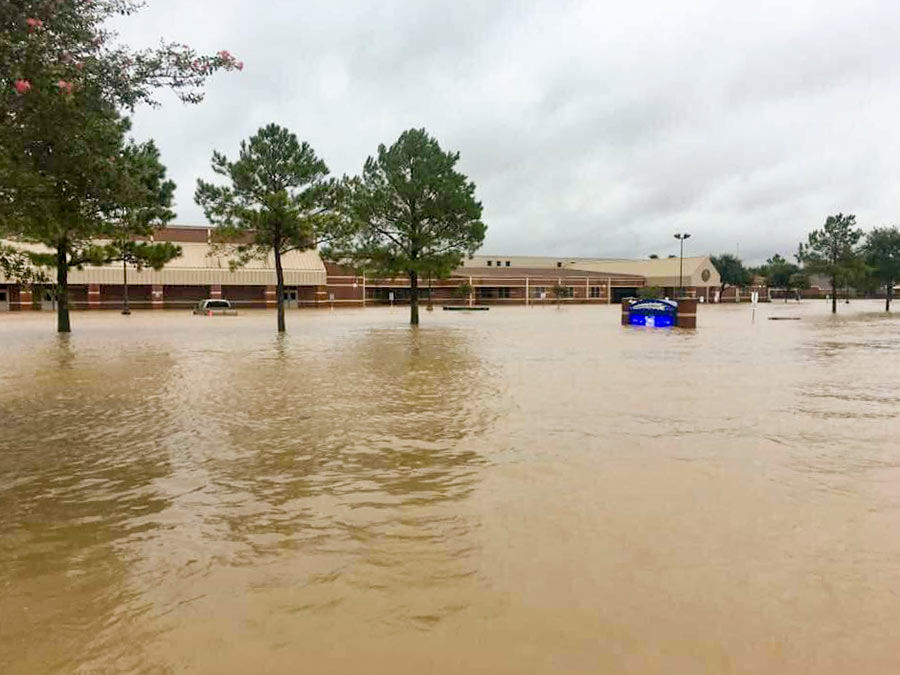 Some documents related to the Katy ISD’s 1998 purchase of the 15-acre site now occupied by Creech Elementary School at 4242 S. Mason Rd. have been frozen — in an attempt to preserve them, after they got flooded when Barker Reservoir got backed up after Hurricane Harvey. What those records might show, once thawed: some explanation for why school officials at the time signed a notice indicating they did not review a map filed with the county by Westbrook Cinco East LP (the developer from whom the property was purchased) that disclosed in a note that the land came with the risk of “extended controlled inundation.” Though several Katy schools sit on land near or in the Barker reservoir flood pool — the area expected to fill up with water when the dam is closed for a major flooding event — only Creech suffered major damage. All 800 Creech students are now attending classes at the University of Houston’s nearby Cinco Ranch campus while the school undergoes an estimated $5 million worth of repairs. The school district’s superintendent tells the Chronicle‘s Lise Olsen that he and other school officials were unaware that the school was built in the flood pool until they were contacted for her story. [Houston Chronicle] Photo of flooding at Creech Elementary School, 4242 S. Mason Rd., Katy: Breta Gatlin
Some documents related to the Katy ISD’s 1998 purchase of the 15-acre site now occupied by Creech Elementary School at 4242 S. Mason Rd. have been frozen — in an attempt to preserve them, after they got flooded when Barker Reservoir got backed up after Hurricane Harvey. What those records might show, once thawed: some explanation for why school officials at the time signed a notice indicating they did not review a map filed with the county by Westbrook Cinco East LP (the developer from whom the property was purchased) that disclosed in a note that the land came with the risk of “extended controlled inundation.” Though several Katy schools sit on land near or in the Barker reservoir flood pool — the area expected to fill up with water when the dam is closed for a major flooding event — only Creech suffered major damage. All 800 Creech students are now attending classes at the University of Houston’s nearby Cinco Ranch campus while the school undergoes an estimated $5 million worth of repairs. The school district’s superintendent tells the Chronicle‘s Lise Olsen that he and other school officials were unaware that the school was built in the flood pool until they were contacted for her story. [Houston Chronicle] Photo of flooding at Creech Elementary School, 4242 S. Mason Rd., Katy: Breta Gatlin
COMMENT OF THE DAY: BEWARE OF NEIGHBORHOOD AVERAGES 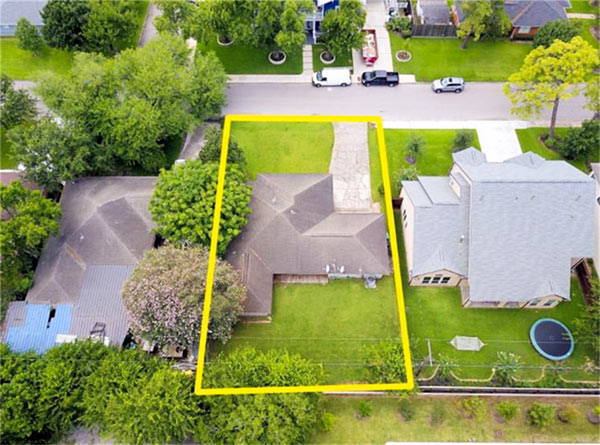 “Anything zoomed out to the neighborhood scale post-Harvey impact-wise waters down the data so much as to be useless. In the Knollwood-Woodside area where homes are “up ~3%,†it’s a mix of ~$800k newbuilds that mostly didn’t flood and ~$400-500k 1950s houses, some of which flooded and many-most that didn’t. That means any additional newbuild sale immediately skews the pricing average. What has already hit the market lately are mostly original homes that flooded, being sold as-is as teardowns (continuing the trend of the neighborhood), with lot-value on an upswing. I guess I presume all of Knollwood will be new construction in the near future, and almost all of ‘greater Braeswood’ being new construction soon, with everything getting higher elevations . . .” [juancarlos31, commenting on Harvey’s Effect on Housing Prices, Neighborhood by Neighborhood; Houston Press Stops the Presses; Astros Fans Flood Downtown] Photo of house for sale at 8311 Lorrie Dr., Knollwood Village: HAR
“Anything zoomed out to the neighborhood scale post-Harvey impact-wise waters down the data so much as to be useless. In the Knollwood-Woodside area where homes are “up ~3%,†it’s a mix of ~$800k newbuilds that mostly didn’t flood and ~$400-500k 1950s houses, some of which flooded and many-most that didn’t. That means any additional newbuild sale immediately skews the pricing average. What has already hit the market lately are mostly original homes that flooded, being sold as-is as teardowns (continuing the trend of the neighborhood), with lot-value on an upswing. I guess I presume all of Knollwood will be new construction in the near future, and almost all of ‘greater Braeswood’ being new construction soon, with everything getting higher elevations . . .” [juancarlos31, commenting on Harvey’s Effect on Housing Prices, Neighborhood by Neighborhood; Houston Press Stops the Presses; Astros Fans Flood Downtown] Photo of house for sale at 8311 Lorrie Dr., Knollwood Village: HAR
2100 MEMORIAL’S EVICTION ORDER, COMPLETELY TRANSFORMED 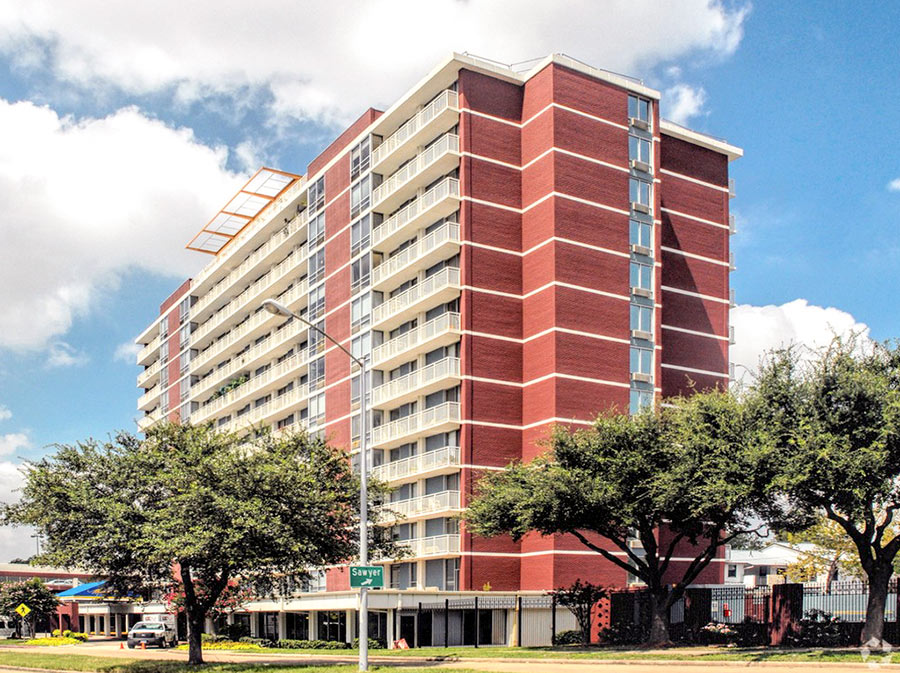 A statement from the Houston Housing Authority yesterday says it “is making every effort to comply” with a judge’s temporary restraining order issued last week ordering the public agency to fix the fire-safety systems at the 14-story 2100 Memorial senior living apartment complex, test the building’s electrical transformers, and replace them if necessary. Judge Daryl Moore also prohibited the authority from terminating the leases of any of its tenants without demonstrating better cause than it has. An estimated 80 percent of the former Holiday Inn’s residents have already moved out. [Houston Chronicle; more; previously on Swamplot]Â Photo: Realtor.com
A statement from the Houston Housing Authority yesterday says it “is making every effort to comply” with a judge’s temporary restraining order issued last week ordering the public agency to fix the fire-safety systems at the 14-story 2100 Memorial senior living apartment complex, test the building’s electrical transformers, and replace them if necessary. Judge Daryl Moore also prohibited the authority from terminating the leases of any of its tenants without demonstrating better cause than it has. An estimated 80 percent of the former Holiday Inn’s residents have already moved out. [Houston Chronicle; more; previously on Swamplot]Â Photo: Realtor.com
A LAKESIDE ESTATES HOME NOW WORTH ITS WEIGHT IN WATER 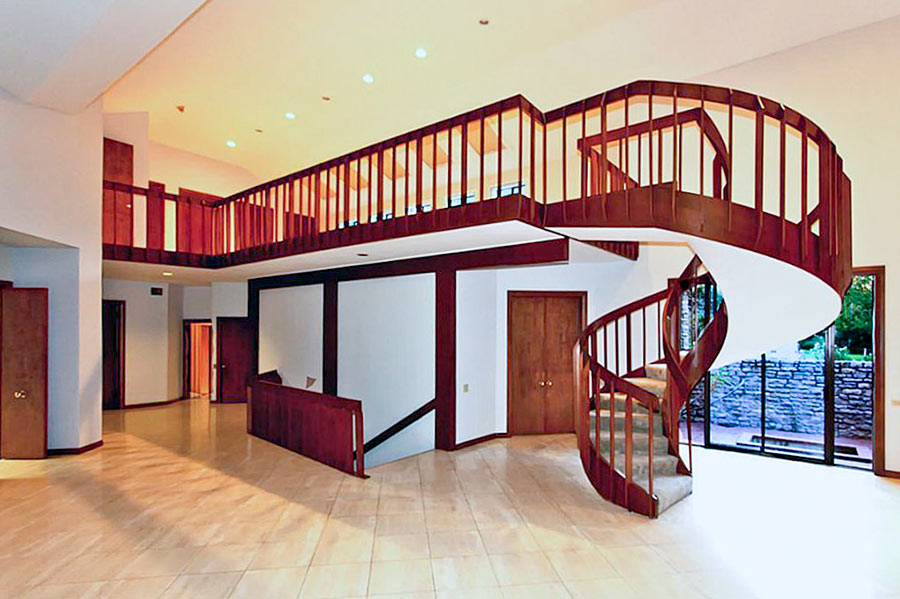 Before the Army Corps of Engineers straightened the section of Buffalo Bayou between Hwy. 6 and Beltway 8 in the mid 1960s, the cul-de-sac at the end of Riverview Dr. in Lakeside Estates wasn’t just near the waterway, it was in it. But the “view” and “side” in the names the subdivision’s developers later attached to the property east of Wilcrest Dr. as they built on it didn’t hold: “When [Allen] Wuescher says he had 17 feet of water inside his house, it’s one of those things you have to see to believe. It is the fifth time in 26 months that his house flooded, and the third time his entire first story was destroyed by water deep enough for a diving board,” writes Meagan Flynn. “Since the home was built in 1979, homeowners at this address have recouped more than $850,000 in flood damage losses through FEMA’s National Flood Insurance Program, at this point making the home more expensive to taxpayers just to exist than for the government to buy it and destroy it. It was appraised at $825,000 by the Harris County Appraisal District. The FEMA flood insurance loss payments so far don’t even include the extraordinary damage wrought by Harvey. And when we enter the home through Wuescher’s garage — which looks like a scene out of The Texas Chainsaw Massacre but with the lights on and with mold instead of blood — it’s immediately clear that the house really is not a house anymore.” [Houston Press] Photo of 10807 River View Dr. living room: Realtor.com
Before the Army Corps of Engineers straightened the section of Buffalo Bayou between Hwy. 6 and Beltway 8 in the mid 1960s, the cul-de-sac at the end of Riverview Dr. in Lakeside Estates wasn’t just near the waterway, it was in it. But the “view” and “side” in the names the subdivision’s developers later attached to the property east of Wilcrest Dr. as they built on it didn’t hold: “When [Allen] Wuescher says he had 17 feet of water inside his house, it’s one of those things you have to see to believe. It is the fifth time in 26 months that his house flooded, and the third time his entire first story was destroyed by water deep enough for a diving board,” writes Meagan Flynn. “Since the home was built in 1979, homeowners at this address have recouped more than $850,000 in flood damage losses through FEMA’s National Flood Insurance Program, at this point making the home more expensive to taxpayers just to exist than for the government to buy it and destroy it. It was appraised at $825,000 by the Harris County Appraisal District. The FEMA flood insurance loss payments so far don’t even include the extraordinary damage wrought by Harvey. And when we enter the home through Wuescher’s garage — which looks like a scene out of The Texas Chainsaw Massacre but with the lights on and with mold instead of blood — it’s immediately clear that the house really is not a house anymore.” [Houston Press] Photo of 10807 River View Dr. living room: Realtor.com
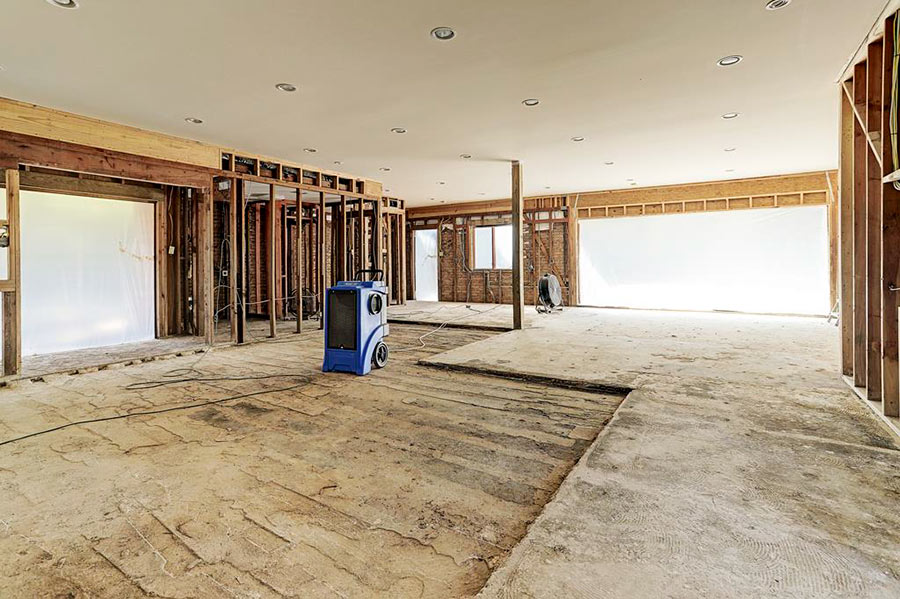
- 17 Legend Ln. [HAR]

